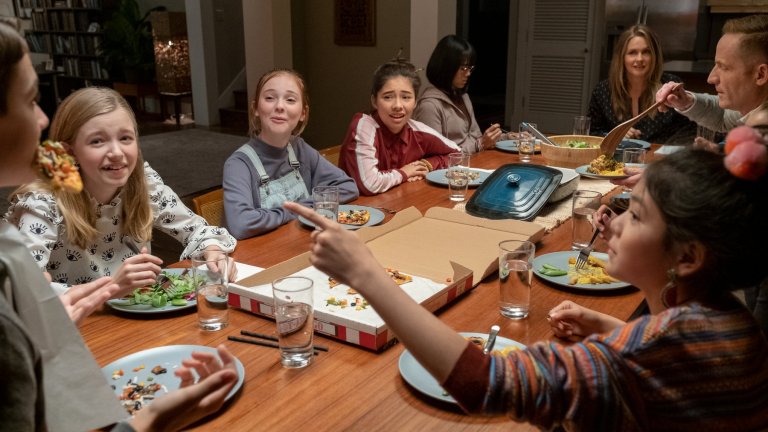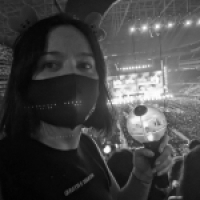Netflix’s Baby-Sitters Club Review
The Baby-Sitters Club remains a celebration of girlhood in many of its forms in Netflix's incredibly smart and wonderfully sweet adaptation of the bestselling book series.

This review is based of off all 10 episodes of The Baby-Sitters Club‘s first season.
The Baby-Sitters Club is more than just a book series. For many, the story is a girlhood institution. First published in 1986 to capitalize on a proven interest for books about babysitting, the would-be franchise was initially conceived as a four book series, but the kid market was hungry for more. More than 30 years later, the series started by Ann M. Martin includes 213 books (not including the spin-offs or graphic novel adaptations) and has sold more than 180 million books in print in more than 20 languages worldwide. Now, Netflix is hoping to build on that legacy with a new TV series.
For the uninitiated, The Baby-Sitters’ Club is the story of a group of enterprising tweens—Kristy (Sophie Grace), Claudia (Momona Tamada), Mary Anne (Malia Baker), and Stacey (Shay Rudolph)—who start their own babysitting club in the fictional town of Stoneybrook, Connecticut. While the original Baby-Sitters Club books were written from 1986 to 2000, the new 10-episode series is firmly set in the now (the club may have a landline for clients to call, but Claudia had to get it off of Etsy) and balances its functions as Millennial nostalgia piece and Zoomer manifesto incredibly well.
When the series references The Parent Trap, it’s the Lindsay Lohan version. When it mentions Broadway, it’s to talk about Hamilton. There are also plenty of Netflix references, from the maybe unintentional “The floor is lava!” to the very-intentional makeover scene that is accompanied by the theme from Queer Eye. The referential nature of the series can sometimes feel unrealistic (does anyone but TV characters make this many allusions?), but it still feels somewhat radical to see mainstream media properties celebrate rather than deride girl culture, so any reference that feels particularly shoehorned in is perhaps more charming here than in the latest comic book movie.
Like each of the main series books, the first eight episodes of the season alternate narrator. (For the final, two-part episode, adapted from Super-Special #2: Baby-sitters’ Summer Vacation, the members of the BSC share narrator duty, as was tradition in the Super-Specials.) We start with go-getter and club founder Kristy Thomas, whose desire to be in control is currently being threatened by excellent mom Elizabeth’s (Alicia Silverstone) relationship with pretty great boyfriend Watson Brewer (Mark Feuerstein). Kristy starts the club as a way to streamline the babysitting-hiring process for parents in the community and, let’s be honest, because she wants to be in charge of something. From the get go, however, it becomes obvious that this isn’t just a brilliant business idea, but also a way for these girls to both practice self-determination and to spend more time with one another.
Over the course of the season, we learn about artist Claudia’s struggles to fit in with anyone besides grandmother Mimi in her Type A family, the reason for Stacey’s move from New York City, and Mary Anne’s steps to find herself without too overwhelming her over-protective father (Marc Evan Jackson). And that is just the beginning. Showrunners Rachel Shukert (GLOW) and Lucia Aniello (Broad City) are brilliant about how they grow this already lived-in world. The most obvious example is the addition of California transplant Dawn (Xochitl Gomez) to the club and narrator duty partway through the season, suggesting that (like the book series) this club and story is inclusive to more than just the four founding members. Fans of the book will also know that certain characters introduced more or less in passing in this first season will become more central as the series (hopefully) continues. This show is laying the groundwork for a much longer story without sacrificing any of the storytelling payoffs of the current season.
This is a wonderfully hopeful and optimistic world, but it isn’t without its nuanced (always solvable) problems. In one episode, Dawn has to babysit a family with an irresponsible parent whose narcissistic tendencies border on neglect. In another episode, Mary Anne must advocate for one of her kid charges when she is misgendered by her doctors. That being said, so far, all of our characters appear to be living in the kinds of comfortable middle class situations that tend to be the TV world default, which of course defines the relationship these characters have with their new business venture—i.e. none of these kids are taking on babysitting jobs so they can help their family’s pay for basic expenses, but rather for pocket money. Of course, the premise is reliant on a middle class setting, as the club needs to exist in a community that has enough financial privilege to be able to afford to hire baby-sitters on the regular.
That being said, this story has an intentional degree of class awareness. Kristy’s struggle to accept her mother’s boyfriend’s place in her family’s life often manifest as issues with his status as coming from the wealthier part of town. Later in the season, Dawn and Claudia push back against a profit-driven camp system that excludes kids from working class families from participating in certain activities. Generally, there has been an effort to diversify this world. In the adaptation, Dawn is no longer a blonde, blue-eyed California girl, but rather Latinx, which is just as if not more so representative of California’s actual population. There has also been an effort to remove or change problematic aspects of the book world. For example, when the BSC go away to camp, it is no longer a camp run by white people called Camp Mohawk. The name has been changed to Camp Moosehead.
Behind the scenes, The Baby-Sitters’ Club boasts a majority (white) women writers and directors. Visually and tonally, it is reminiscent of the bright, glossy charms of Netflix book-to-film adaptation To All the Boys I’ve Loved Before, though aimed to be appropriate for a slightly younger audience. There’s a sense inherent to this world that nothing truly bad will happen to these kids while we are watching. That no irreversible horrors will visit these sweet characters or their charges. That this world wants to see them succeed, even if they stumble along the way. It’s perhaps a function of the characters’ relative privilege, but (at least for this white woman viewer) that doesn’t make spending time in this world any less of a balm.
The Baby-Sitters Club will be available in its entirety July 3rd on Netflix.
